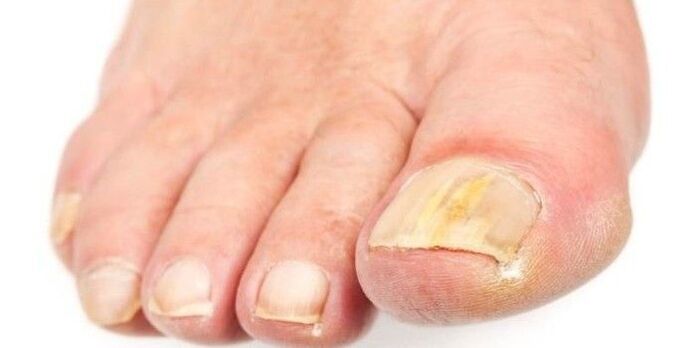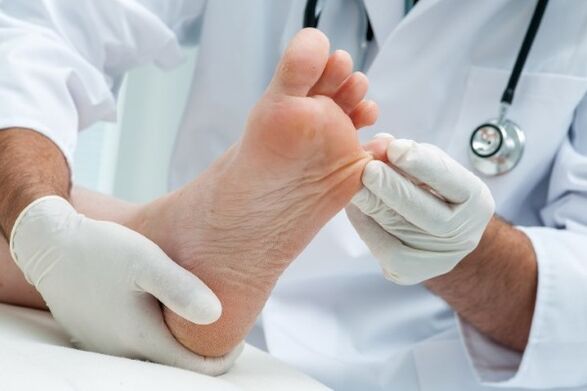The fungus, also known as onycomycosis, is a nail surface infection caused by dermatophytes, yeast or mold.
The nail color changes, first acquires a white tinge, then darker and can smell badly. Plays, deforms, begins to destroy.
There is a high probability that the infection spreads to other nails in the legs and adjacent skin. The caress will appear when you walk, wear shoes. Therefore, the fungus should be treated in time.
Causes of nail fungus

The causes of onychomycosis are quite banal:
If there were irritations, the legs sweat a lot, and the shoes are poorly cramped and ventilated for long periods of time - this is an ideal environment for increasing the dispute.
Symptoms of nail fungus
The most common symptom caused by a fungal infection is the thickening of the plaque. The nail can whiten, have white, black, yellow or green.
With the development of the disease, it becomes fragile, small nail pieces break down or can be completely separated from the finger. If you do not pay close attention, the skin underneath is swollen, it becomes painful, scaly. An unpleasant odor occurs
If the disease is not working, there are usually no other symptoms. Sometimes the body can respond to fungi on the skin without damage. A rash or itching caused by dermatophytes can be an allergic reaction of the body to a fungus.
Risk factors for the development of nail fungus
Anyone can have an infection on the toe, but there are several risk factors that make a person more prone to infection with fungal nails. Some of them are as follows:
The complications of the fungus
A severe foot infection can be very painful and lead to constant damage to your nails. If a person has an immune system in depression, diabetes or any other chronic illness, there is a high risk of complications. With diabetes, blood circulation decreases and neuropathy often occurs. Sometimes you can't perceive pain.
So, not only nails for nails, but also any minor injury to the legs can be a serious problem. If a person has diabetes, and he thinks he has an infection, it is reasonable to visit a doctor.
Testing and Diagnosis
Nail fungal infection is sometimes mistakenly diagnosed as psoriasis, contact dermatitis and tumors, such as melanoma. Laboratory tests may be required to avoid an incorrect diagnosis.
As a rule, three approaches are used:
These three approaches use microscopic studies of material from nails taken from scrapers or trimming.
According to some recent improvements, from the point of view of sensitivity, the most useful are direct strokes, histological examination and nail plate biopsy using the periodic chiffon acid spoon.
Some samples may be required to diagnose the fungal organisms correctly.
PREVENTION

The first step that can be taken to prevent infections of the fungus in the foot is to observe the right hygiene. Clean and dry legs definitely prevent any fungal infection.
Performing regular regular soap adjustment and remember to dry them after the procedure. In public places you need to wear shower slippers.
You can need to change shoes, socks and underwear more than once a day.
Improve the nail cutting technique - cut them so that the nails do not go beyond your feet.
Maybe you will need to wear shoes that do not fit tightly with your fingers, and their material should be such as to provide ventilation.
Avoid wearing cotton socks or wool. Prefer socks made of special synthetic fibers that take moisture from the feet more efficiently than cotton and wool.
Drink nails and pedicure tools. Do not use spray on nails that have an infection.
When you see a doctor
It is worth setting a meeting with your doctor if your nail fungus infection causes bacterial signs: you should check the list of signs and symptoms for accurate diagnosis and accurate drug choice.
The doctor will examine the patient, hear complaints, after which primary tests are carried out by collecting the biomaterial to determine the type of fungus. Then a thorough analysis of the results and the purpose of the therapy.
Treatment and affordable medicines
If the fungal infection is mild, there is no need for complex treatment. However, ignorance can lead to its spread on other nails. Below are the treatment options available for nail fungus:
Medicines are usually recommended when fungal nail infection is serious.
You may need to take the medicine for several months so that the infection has gone. The drug stop will lead to a return very early. Some side effects of medication may include headaches, itching, loss of taste, nausea and diarrhea.
If a person does not want to take pills, the doctor will advise instead of using the nail plate. It is not as effective as oral products because it cannot always penetrate deep into the nail into the focus of the infected area. Terms of use reach 12 months.
Chemical removal of nails
An abnormal searching nail can be chemically removed using a paste containing 40% urea. Pasta is easily available at the pharmacy. You need to tie it to the nails, cover it and leave it overnight. Rinse the pasta in the morning and repeat the procedure daily. The infected plaque will be distributed after about 2 weeks.
This is a painless treatment option that removes the patient with nail, and also gradually removes mycosis. With such treatment, it is not necessary to take the pills for several months and the operation can be avoided.
Surgery and laser therapy
Surgery for removing an infected nail is recommended only in difficult conditions, if it becomes very painful, and other methods of treatment do not help. After surgery, the nail will begin to grow again, however, one year may be required for complete recovery.
Is laser treatment a good opportunity to get rid of nail fungus?
In the case of a stubborn nail infection, laser treatment is possible. The laser radiates high doses of light energy, which kills and destroys the fungus.
According to the research, laser therapy is completely safe, and the treatment rate is 90% after 3 months. However, it requires repetition every three months during the year and is not free.
How long can you treat nail fungus?
Treating nail infection can be a long and expensive process.
Periral drugs work on average about four months, while the infected nail is replaced by healthy.
When using antifungal nail plate, the duration of treatment increases and can take about one year.
Laser and surgical removal yields faster results.
















